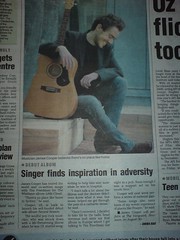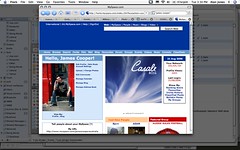One very cool feature of my new Sony Ericsson's K800i's 3 megapixel camera is the 'document' setting, which optimises the focus, flash and exposure to allow you to use the phone as a quick and cheap scanner.
Here's an unretouched shot of a story from a newspaper. The original document is about 250mm x 300mm. It's more than clear enough to read the body type and could easily be fed into your OCR software.
Next time my HP multifunction printer/scanner thingy goes bing I'm going to recycle it, buy a cheap laserprinter, and just use the camera as my scanner - it rocks.
A phone as a scanner has a number of advantages. You don't need to have a flat document when you scan, you can use the viewfinder to position the image for scanning, you can stealthily snap all kinds of documents (e.g. recipes right out of magazines) that you don't own and don't want to buy (copyright law not withstanding), and you can shoot things like fine print on public signs that you can't just dismantle and drag home.
Thursday, August 31
Tuesday, August 22
myspace.com's .AU ad inventory sold to... an ad agency?
So if MySpace is such a valuable chunk of advertising inventory, can someone explain to me why all the impressions on .AU eyeballs today seem to be sold to www.casalemedia.com?
Monday, August 21
Liquid bombs on planes - a danger only to the bomber?
Gotta take some things you read in The Register with a tiny grain of salt but this analysis of whether it's possible to build a bomb onboard an aircraft using liquid precursors seems detailed and factual, and its conclusions are rather terrifying. In summary:
- It's probably not possible to blow up a plane by combining the most likely liquids used by the terrorists. It is possible to make a small explosion, but likely that the bomber would be the only person killed, since the ingredients are very unstable and it would be incredibly difficult to mix them safely once onboard.
- The explosives would be more effective (though even more unstable) if mixed and then brought on-board, and they would be easy to get through security (since it just looks like a white powder) but it's more likely the bombers would blow themselves up trying to transport the explosives to the airport.
- Explosives are just as easy to detonate remotely via mobile phone when they are stored in the cargo hold, and it's still quite easy to get checked-in luggage onto a plane without much of a security scan.

In summary, the response from the authorities following the latest UK terrorist action has been to ban the wrong materials, from the wrong part of the plane. At least, that's true if you want to reduce the risk of terrorists blowing up a plane. If all you want to do is make it look like you're taking it all seriously and taking steps to avoid bombings, what the authorities have done is effective enough.
Friday, August 18
Liquid bombs on plane - a danger only to the bomber?
Gotta take some things you read in The Register with a tiny grain of salt but this analysis of whether it's possible to build a bomb onboard an aircraft using liquid precursors seems detailed and factual, and its conclusions are rather terrifying. In summary:
- It's probably not possible to blow up a plane by combining the most likely liquids used by the terrorists. It is possible to make a small explosion, but likely that the bomber would be the only person killed, since the ingredients are very unstable and it would be incredibly difficult to mix them safely once onboard.
- The explosives would be more effective (though even more unstable) if mixed and then brought on-board, and they would be easy to get through security (since it just looks like a white powder) but it's more likely the bombers would blow themselves up trying to transport the explosives to the airport.
- Explosives are just as easy to detonate remotely via mobile phone when they are stored in the cargo hold, and it's still quite easy to get checked-in luggage onto a plane without much of a security scan.

In summary, the response from the authorities following the latest UK terrorist action has been to ban the wrong materials, from the wrong part of the plane. At least, that's true if you want to reduce the risk of terrorists blowing up a plane. If all you want to do is make it look like you're taking it all seriously and taking steps to avoid bombings, what the authorities have done is effective enough.
Tuesday, August 1
Stop attacking Lebanon!
Civilised nations do not invade a sovereign nation in order to retaliate against a terrorist action. Hezbollah is in Lebanon, but it does not represent the state of Lebanon, or the Lebanese people.
Anyway, great tee shirt.
Anyway, great tee shirt.
Subscribe to:
Posts (Atom)






